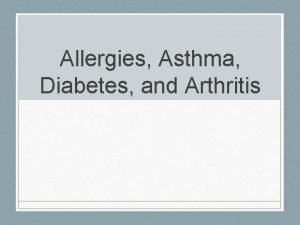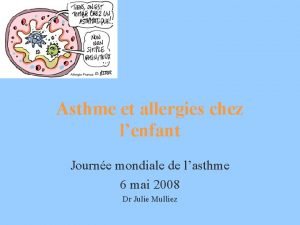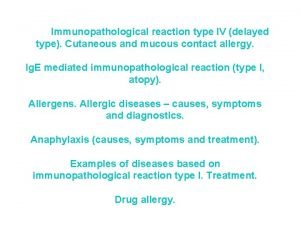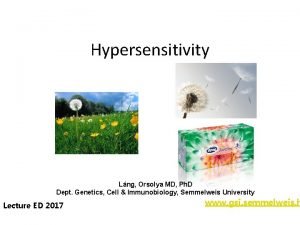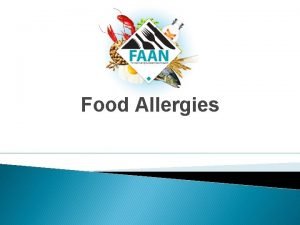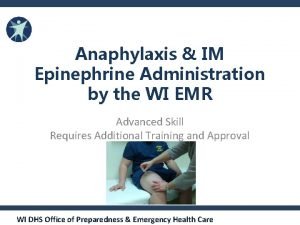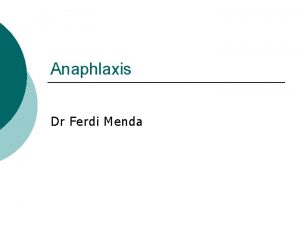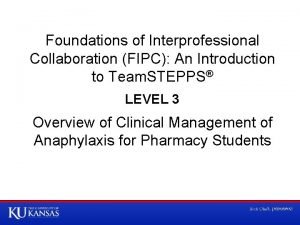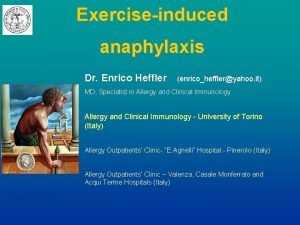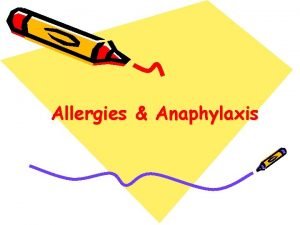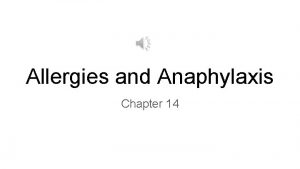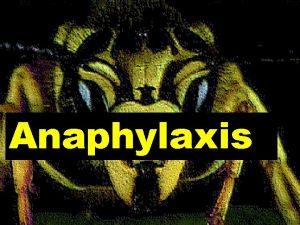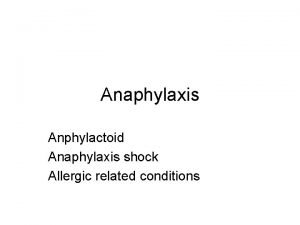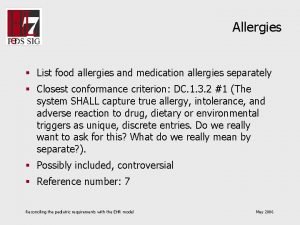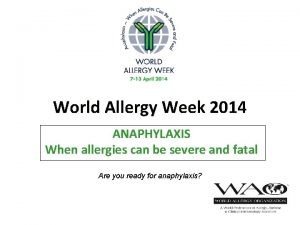Allergies and Anaphylaxis Chapter 14 Terms Allergy an











- Slides: 11

Allergies and Anaphylaxis Chapter 14

Terms ● Allergy: an exaggerated immune response to a substance that does not normally cause a reaction ● Allergic Reaction: a series of signs and symptoms that occur in response to exposure to an allergen ● Antigen: foreign substance that when introduced into the body stimulates an immune reaction ● Antibody: a protein that is produced by the body to neutralize or destroy specific antigens

More Terms ● Hypersensitivity: an exaggerated immune response to an allergen, drug, or other foreign substance ● Anaphylaxis: a severe allergic reaction that can result in serious cardiac or respiratory compromise ● Allergen: a foreign substance whose presence in the body stimulates an allergic reaction ● Histamine: a chemical released in the body as a result of an allergic reaction

Common Causes of Allergies ● Foods (peanuts, shellfish, nuts, soy, milk, eggs, chocolate) ● Insect bites and stings ● Environmental irritants (smoke, airborne particles) ● Pollen and plant parts (weeds, grasses, trees) ● Molds (mildew, spores) ● Animal dander (skin, flakes, fur) ● Medications (antibiotics, pain medications) ● Chemicals (latex)

Mild Allergic Reaction -Urticaria: hives or rashes that accompany an allergic reaction -Pruritus: severe itching -Tingling in and around mouth -Swelling of nasal mucosa, runny nose, congestion, sneezing, watery red eyes -Feeling tired or run down -Watery, red eyes -Increased heart rate

Moderate Allergic Reaction -All mild symptoms -but hives also on chest and arms -Angioedema: swelling occurs beneath the skin or mucosa -Skin can become flushed or pale -Gastro can also be affected → abdominal pain, cramping, nausea, vomitibg -Tightness in throat, difficulty swallowing -Difficulty breathing, wheezing

Severe Allergic Reaction -Changes in respiratory, circulatory, gastrointestinal, release of massive amounts of histamine -Hives may cover entire upper body -Angioedema very pronounced -Blood vessels dilate causing fall in blood pressure, weak pulse -Anaphylaxis = sudden collapse of respiratory and circulatory system -LOR decreases -Increased heart and respiratory rates

Anaphylactic Shock -Systolic blood pressure below 90 mm. Hg -Respirations greater than 20 rpm -Heart rate greater than 110 bpm -Decreased LOR

Management -Correct any ABCD-related problems -Open the airway -Oxygen should be given using a nonrebreather mask at 15 LPM -Remove any tight-fitting necklaces, watches, rings, bracelets -Transport -If applicable assist patient in injecting epinephrine -Place any patient that shows signs of shock in a supine position with feet elevated

Epinephrine -promotes bronchodilation and vasoconstriction, thus relieving dyspnea and hypotension -ensure medication is prescribed for the patient, and check expiration date -take off cap, firmly inject into thigh for at least 10 seconds, ASSIST the patient in giving themselves their epinephrine (for legal reasons, get them to hold it) -note time of injection -massage the injection site for 10 -20 seconds -always transport if you have given epinephrine, even if the patient seems better

